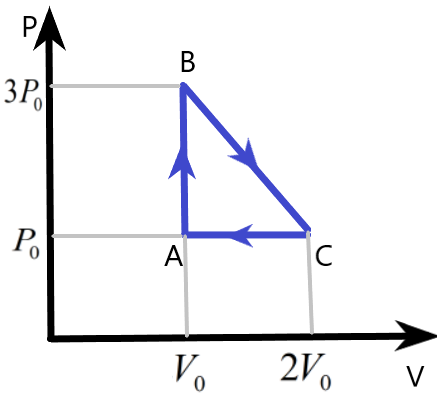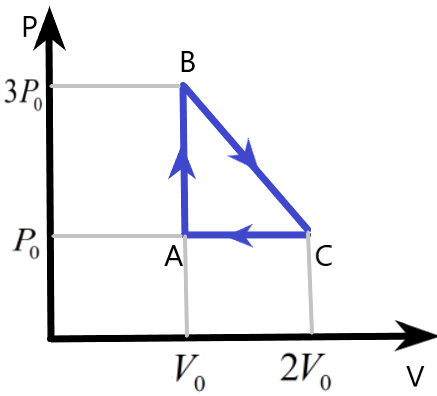Answer
385.5k+ views
Hint: We need to understand the relation between the pressure and volume variation in a cyclic process of a monatomic gases with the heat absorption and the heat rejection of the system and the net work done in order to solve this problem.
Complete answer:
We are given a cyclic process of an ideal monatomic gas with the help of a diagram. The pressure and volume variation of the system is plotted which can be used to find the other parameters involved in this system during the process.

We know that the work done by the gas in the cyclic process can be easily found by finding the area under the pressure – volume curve of the process. Here, the area of the triangle ABC will give us the work done W, as –
\[\begin{align}
& W=\text{Area of }\Delta \text{ABC} \\
& \Rightarrow W=\dfrac{1}{2}\times AB\times AC \\
& \Rightarrow W=\dfrac{1}{2}\times \left( 3{{P}_{0}}-{{P}_{0}} \right)\times \left( 2{{V}_{0}}-{{V}_{0}} \right) \\
& \therefore W={{P}_{0}}{{V}_{0}} \\
\end{align}\]
Now, we can find the heat rejected by the process in CA as –
\[\begin{align}
& {{Q}_{CA}}=n{{C}_{P}}\Delta T \\
& \Rightarrow {{Q}_{CA}}=n\left( \dfrac{5}{2}R \right)\Delta T \\
& \Rightarrow {{Q}_{CA}}=\left( \dfrac{5}{2} \right)\left( {{P}_{A}}{{V}_{A}}-{{P}_{C}}{{V}_{C}} \right)\text{ }\because PV=nRT \\
& \Rightarrow {{Q}_{CA}}=\dfrac{5}{2}R\left( {{P}_{0}}{{V}_{0}}-{{P}_{0}}2{{V}_{0}} \right) \\
& \therefore {{Q}_{CA}}=-\dfrac{5}{2}{{P}_{0}}{{V}_{0}} \\
\end{align}\]
Also, the heat absorbed by the process along AB is given similarly as –
\[\begin{align}
& {{Q}_{AB}}=n{{C}_{V}}\Delta T \\
& \Rightarrow {{Q}_{AB}}=n\left( \dfrac{3}{2}R \right)\Delta T \\
& \Rightarrow {{Q}_{AB}}=\left( \dfrac{3}{2} \right)\left( {{P}_{B}}{{V}_{B}}-{{P}_{A}}{{V}_{A}} \right)\text{ }\because PV=nRT \\
& \Rightarrow {{Q}_{AB}}=\dfrac{3}{2}R\left( 3{{P}_{0}}{{V}_{0}}-{{P}_{0}}{{V}_{0}} \right) \\
& \therefore {{Q}_{AB}}=3{{P}_{0}}{{V}_{0}} \\
\end{align}\]
Now, the net heat absorbed by the gas along BC is the work done by the gas along the path, which is the area under the line BC.
\[\begin{align}
& {{Q}_{BC}}={{W}_{BC}}=\text{Area under BC} \\
& \Rightarrow {{\text{W}}_{BC}}=\left( 2{{V}_{0}}-{{V}_{0}} \right)\times \left( 3{{P}_{0}}-{{P}_{0}} \right) \\
& \therefore {{W}_{BC}}=2{{P}_{0}}{{V}_{0}} \\
\end{align}\]
These are the required solutions for the given problem –
(a) \[W={{P}_{0}}{{V}_{0}}\]
(b) \[{{Q}_{CA}}=-\dfrac{5}{2}{{P}_{0}}{{V}_{0}}\]
\[{{Q}_{AB}}=3{{P}_{0}}{{V}_{0}}\]
(c) \[{{W}_{BC}}=2{{P}_{0}}{{V}_{0}}\]
This is the required solution.
Note:
The pressure and volume variation for an ideal gas at a constant temperature is dependent on each other as given by Boyle's law. The pressure exerted by the gas is inversely proportional to the volume occupied of the gas according to this law.
Complete answer:
We are given a cyclic process of an ideal monatomic gas with the help of a diagram. The pressure and volume variation of the system is plotted which can be used to find the other parameters involved in this system during the process.

We know that the work done by the gas in the cyclic process can be easily found by finding the area under the pressure – volume curve of the process. Here, the area of the triangle ABC will give us the work done W, as –
\[\begin{align}
& W=\text{Area of }\Delta \text{ABC} \\
& \Rightarrow W=\dfrac{1}{2}\times AB\times AC \\
& \Rightarrow W=\dfrac{1}{2}\times \left( 3{{P}_{0}}-{{P}_{0}} \right)\times \left( 2{{V}_{0}}-{{V}_{0}} \right) \\
& \therefore W={{P}_{0}}{{V}_{0}} \\
\end{align}\]
Now, we can find the heat rejected by the process in CA as –
\[\begin{align}
& {{Q}_{CA}}=n{{C}_{P}}\Delta T \\
& \Rightarrow {{Q}_{CA}}=n\left( \dfrac{5}{2}R \right)\Delta T \\
& \Rightarrow {{Q}_{CA}}=\left( \dfrac{5}{2} \right)\left( {{P}_{A}}{{V}_{A}}-{{P}_{C}}{{V}_{C}} \right)\text{ }\because PV=nRT \\
& \Rightarrow {{Q}_{CA}}=\dfrac{5}{2}R\left( {{P}_{0}}{{V}_{0}}-{{P}_{0}}2{{V}_{0}} \right) \\
& \therefore {{Q}_{CA}}=-\dfrac{5}{2}{{P}_{0}}{{V}_{0}} \\
\end{align}\]
Also, the heat absorbed by the process along AB is given similarly as –
\[\begin{align}
& {{Q}_{AB}}=n{{C}_{V}}\Delta T \\
& \Rightarrow {{Q}_{AB}}=n\left( \dfrac{3}{2}R \right)\Delta T \\
& \Rightarrow {{Q}_{AB}}=\left( \dfrac{3}{2} \right)\left( {{P}_{B}}{{V}_{B}}-{{P}_{A}}{{V}_{A}} \right)\text{ }\because PV=nRT \\
& \Rightarrow {{Q}_{AB}}=\dfrac{3}{2}R\left( 3{{P}_{0}}{{V}_{0}}-{{P}_{0}}{{V}_{0}} \right) \\
& \therefore {{Q}_{AB}}=3{{P}_{0}}{{V}_{0}} \\
\end{align}\]
Now, the net heat absorbed by the gas along BC is the work done by the gas along the path, which is the area under the line BC.
\[\begin{align}
& {{Q}_{BC}}={{W}_{BC}}=\text{Area under BC} \\
& \Rightarrow {{\text{W}}_{BC}}=\left( 2{{V}_{0}}-{{V}_{0}} \right)\times \left( 3{{P}_{0}}-{{P}_{0}} \right) \\
& \therefore {{W}_{BC}}=2{{P}_{0}}{{V}_{0}} \\
\end{align}\]
These are the required solutions for the given problem –
(a) \[W={{P}_{0}}{{V}_{0}}\]
(b) \[{{Q}_{CA}}=-\dfrac{5}{2}{{P}_{0}}{{V}_{0}}\]
\[{{Q}_{AB}}=3{{P}_{0}}{{V}_{0}}\]
(c) \[{{W}_{BC}}=2{{P}_{0}}{{V}_{0}}\]
This is the required solution.
Note:
The pressure and volume variation for an ideal gas at a constant temperature is dependent on each other as given by Boyle's law. The pressure exerted by the gas is inversely proportional to the volume occupied of the gas according to this law.
Recently Updated Pages
How many sigma and pi bonds are present in HCequiv class 11 chemistry CBSE

Why Are Noble Gases NonReactive class 11 chemistry CBSE

Let X and Y be the sets of all positive divisors of class 11 maths CBSE

Let x and y be 2 real numbers which satisfy the equations class 11 maths CBSE

Let x 4log 2sqrt 9k 1 + 7 and y dfrac132log 2sqrt5 class 11 maths CBSE

Let x22ax+b20 and x22bx+a20 be two equations Then the class 11 maths CBSE

Trending doubts
Fill the blanks with the suitable prepositions 1 The class 9 english CBSE

At which age domestication of animals started A Neolithic class 11 social science CBSE

Which are the Top 10 Largest Countries of the World?

Give 10 examples for herbs , shrubs , climbers , creepers

Difference between Prokaryotic cell and Eukaryotic class 11 biology CBSE

Difference Between Plant Cell and Animal Cell

Write a letter to the principal requesting him to grant class 10 english CBSE

Change the following sentences into negative and interrogative class 10 english CBSE

Fill in the blanks A 1 lakh ten thousand B 1 million class 9 maths CBSE




